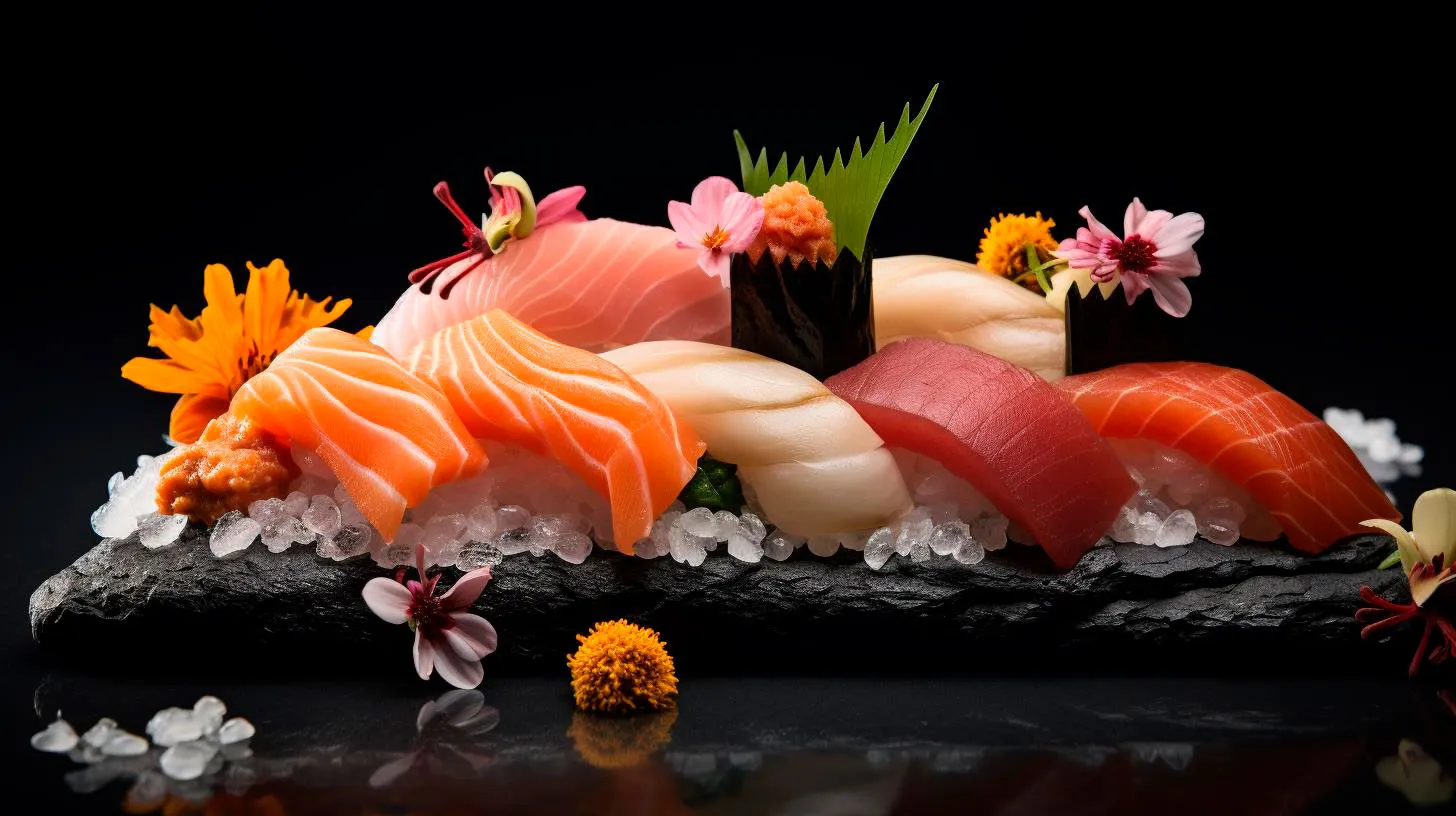The Art of Adaptation: Sushi Allergies in Different Culinary Traditions
In this article, we will explore how sushi is adapted to accommodate allergies in various countries and the fascinating art of sushi adaptation.
The Rise of Food Allergies
Food allergies have become a growing concern in recent years. According to a study conducted by the Food Allergy Research & Education (FARE) organization, an estimated 32 million Americans have food allergies. This represents an alarming increase of 377% since 2007. With such a significant number of people affected, it is crucial for the culinary industry to adapt and cater to these special dietary needs.
Among the most common food allergies are those related to seafood, particularly fish allergies. Fish and shellfish allergies affect approximately 1.2% of the population worldwide. This poses a challenge for sushi lovers who are allergic to certain types of fish. However, the art of adaptation allows individuals with allergies to still enjoy this delectable cuisine.
Adapting Sushi in Traditional Japanese Cuisine
In Japan, sushi is deeply rooted in tradition and culinary excellence. It may seem challenging to adapt such an authentic cuisine, but Japanese chefs have found innovative ways to cater to sushi lovers with allergies.
1. Fish Substitutes
One of the main adaptations in traditional sushi is the use of fish substitutes. Chefs often replace raw fish with alternative ingredients like tofu, avocado, or even cooked vegetables. This not only caters to those with fish allergies but also provides a variety of flavor profiles for sushi enthusiasts to explore.
2. Allergen-Free Ingredients
Japanese cuisine is known for its meticulous attention to detail when it comes to ingredients. Chefs pay close attention to the use of allergen-free ingredients, ensuring that the sushi remains safe for those with allergies. From specially prepared rice to gluten-free soy sauce, every aspect of the dish is tailored to accommodate various dietary needs.
Adapting Sushi in Western Culinary Traditions
As sushi gained popularity in the Western world, it underwent its own adaptations to suit local palates and dietary restrictions. Here are some ways sushi has been adapted to cater to allergies in Western culinary traditions:
1. Cooked Sushi
Western adaptations often include a focus on cooked sushi options. This not only appeals to those with fish allergies but also to individuals who prefer their seafood cooked. Cooked sushi varieties like tempura rolls or California rolls provide an excellent alternative for those seeking a safe and flavorful sushi experience.
2. Vegetarian and Vegan Options
The rise of vegetarian and vegan lifestyles has led to the popularity of plant-based alternatives in sushi. Western-style sushi often offers a wide range of vegetarian and vegan options, where fish is substituted with ingredients like cucumber, sweet potato, or tofu. These adaptations provide allergen-free alternatives while still maintaining the essence and flavors of sushi.
The Art of Sushi Adaptation
The art of sushi adaptation highlights the creativity and innovation within the culinary world. Chefs worldwide embrace the challenge of accommodating food allergies while maintaining the integrity of this ancient cuisine. As a result, sushi has become accessible to a wider range of individuals with dietary restrictions.
Key Takeaways:
- Sushi has gained immense popularity worldwide, leading to the need for adaptation to accommodate food allergies.
- Traditional Japanese cuisine has found ways to substitute fish and use allergen-free ingredients.
- Western culinary traditions focus on cooked sushi and offer vegetarian and vegan options.
- The art of sushi adaptation showcases the creativity and innovation within the culinary industry.
As the culinary world continues to evolve, the art of adaptation plays a vital role in ensuring that individuals with allergies can still enjoy the pleasures of dining. Sushi, with its rich history and intricate flavors, is a prime example of how traditional cuisines can adapt to diverse dietary needs.
Globally Loved, Locally Allergic: Understanding Sushi Allergies
Food allergies are on the rise, affecting millions of people globally. According to the Food Allergy Research & Education (FARE), approximately 32 million Americans have a food allergy, with shellfish being one of the most common triggers. As sushi frequently contains shellfish, it is crucial to understand sushi allergies, their symptoms, and how to navigate sushi options with allergies in mind.
Common Allergens Present in Sushi
Sushi is typically made with a combination of fish, rice, seaweed, and various other ingredients. While sushi can be a healthy and delicious choice for many, it can be problematic for those with allergies. Some common allergens found in sushi include:
- Shellfish: Crab, shrimp, lobster, and other types of shellfish are commonly used in sushi. Shellfish allergies are among the most prevalent food allergies, with reactions ranging from mild to life-threatening.
- Fish: Tuna, salmon, and mackerel are just a few of the fish commonly used in sushi. Fish allergies are also quite common and can cause severe allergic reactions.
- Soy: Soy sauce is a staple in sushi, but it can cause allergic reactions in individuals with soy allergies. Those with soy allergies should opt for gluten-free soy sauce or avoid it altogether.
- Gluten: People with gluten intolerance or celiac disease should be cautious when consuming sushi, particularly the fillings and sauces that may contain wheat-based ingredients.
Symptoms and Reactions
When someone with a sushi allergy consumes allergenic ingredients, they may experience a range of symptoms, including:
- Hives or skin rash
- Swelling of the lips, tongue, or throat
- Difficulty breathing or shortness of breath
- Nausea, vomiting, or stomach cramps
- Diarrhea
- Dizziness or lightheadedness
In severe cases, a sushi allergy can lead to anaphylaxis, a life-threatening allergic reaction that requires immediate medical attention. Symptoms of anaphylaxis include difficulty breathing, a drop in blood pressure, rapid pulse, and loss of consciousness.
Preventing Sushi Allergic Reactions
If you have a sushi allergy or suspect you might have one, it’s crucial to take certain preventive measures. Here are some key takeaways:
- Read Labels: Always carefully read the ingredient labels on sushi packaging, especially if you are dining out. Look out for common allergens such as shellfish, fish, soy, and gluten.
- Communicate with the Waitstaff: When dining at a sushi restaurant, inform the waitstaff about your allergies. They can guide you in choosing safe options or make necessary modifications to your order.
- Choose Allergen-Free Alternatives: Look for sushi options that do not contain allergens you are sensitive to. Many sushi restaurants offer vegetarian or vegan rolls that can be enjoyed without concerns.
- Consider Cross-Contamination: Cross-contamination can occur between sushi rolls with different fillings or through shared utensils. Ensure the restaurant takes appropriate measures to prevent cross-contamination.
- Carry Medication: If you have a known sushi allergy, it’s essential to carry an epinephrine auto-injector (EpiPen) with you at all times. This can help manage severe allergic reactions until medical help arrives.
The Growing Awareness
As food allergies become more prevalent, sushi restaurants and the food industry as a whole are becoming more attentive and accommodating to individuals with allergies. Many sushi establishments now offer allergy-friendly menus and have allergen information available upon request. This growing awareness makes it easier for sushi lovers with allergies to enjoy their favorite dish safely.
In conclusion, understanding sushi allergies is critical to ensure the safety and well-being of those with sensitivities. By being aware of the common allergens in sushi, the symptoms of allergic reactions, and taking preventive measures, individuals with allergies can still indulge in the joy of sushi safely.
Sushi Allergies Across Cultures: A Closer Look
In this article, we take a closer look at sushi allergies, their prevalence, and how they differ across cultures.
The Prevalence of Sushi Allergies
Allergies to sushi ingredients are not uncommon, and they can vary depending on the specific ingredients and individuals. Some common allergies associated with sushi consumption include:
- Seafood Allergies: Many people are allergic to various types of seafood, such as fish, shellfish, or crustaceans. These allergies can cause symptoms ranging from mild discomfort to severe reactions like anaphylaxis.
- Soy Allergies: Soy sauce, a staple condiment in sushi, contains soybeans. People with soy allergies may experience digestive issues, skin rashes, or even respiratory problems.
- Seaweed Allergies: Nori, the seaweed used to wrap sushi rolls, can also trigger allergies in some individuals. Symptoms may include itching, swelling, or difficulty in breathing.
It is essential to keep in mind that people can develop allergies to any ingredient, so it’s crucial to approach sushi consumption with caution. If you have a known food allergy, consult with a healthcare professional before indulging in sushi or any dish that contains potentially allergenic ingredients.
Sushi Allergies Across Cultures
Sushi has been adapted and modified in many countries to suit local tastes and preferences. This cultural evolution has led to variations in sushi ingredients and preparations, consequently affecting the prevalence of sushi allergies. Let’s delve into how sushi allergies differ across cultures:
Traditional Japanese Sushi
In Japan, sushi is predominantly consumed with raw fish, such as salmon, tuna, and mackerel. Allergies to these fish varieties are relatively common, affecting around 4-6% of the Japanese population. Symptoms may include itching, hives, or gastrointestinal issues. However, it is worth noting that the prevalence of sushi allergies in Japan is generally lower compared to other countries due to higher genetic compatibility.
Westernized Sushi
As sushi gained popularity in Western countries, it underwent significant adaptations to cater to local tastes. Cooked or smoked fish, as well as vegetarian options like avocado or cucumber, became more common. This shift in ingredients led to a decrease in seafood allergies while giving rise to new concerns.
Westernized sushi often incorporates soy sauce, which can trigger allergic reactions in those with soy allergies. Moreover, cross-contamination in sushi preparation, especially in restaurants serving a variety of dishes, can also be a concern for individuals with severe allergies.
Key Takeaways
- Various allergies can be associated with sushi consumption, including seafood, soy, and seaweed allergies.
- Prevalence and types of sushi allergies can vary across cultures due to differences in ingredients and genetic compatibility.
- Traditional Japanese sushi is often consumed with raw fish, making allergic reactions to specific seafood varieties more common.
- Westernized sushi incorporates cooked fish, smoked fish, and vegetarian options, reducing seafood allergies but introducing concerns related to soy allergies.
- Individuals with known food allergies should exercise caution when consuming sushi and consult with healthcare professionals if necessary.
Sushi allergies are a topic that deserves attention and awareness. Understanding the prevalence, distinguishing between cultures, and knowing your own allergies can help ensure a safe and enjoyable experience when indulging in this beloved culinary art form.
Crossing Borders Crossing Allergies Unveiling Sushi Allergies Worldwide
The Rise of Sushi Allergies
Sushi allergies have been on the rise in recent years, affecting individuals from different parts of the globe. This increase in allergies may be attributed to various factors, including the globalization of food and ingredients. As sushi ingredients are sourced from different parts of the world, the chances of encountering unfamiliar allergens increase significantly.
Studies have shown that seafood, especially shellfish like shrimp and crab, is the primary cause of sushi allergies. These allergies are commonly classified as IgE-mediated, where the immune system overreacts to specific proteins present in seafood. Other ingredients such as seaweed, soy sauce, and wasabi can also trigger allergies in certain individuals.
The Symptoms and Impact
Sushi allergies can manifest in various ways, ranging from mild to severe symptoms. Some common symptoms include:
- Itchy skin and hives
- Nasal congestion and sneezing
- Abdominal pain and nausea
- Difficulty breathing and wheezing
In severe cases, sushi allergies can lead to anaphylaxis, a life-threatening allergic reaction that requires immediate medical attention. It is essential for individuals with known allergies to avoid consuming sushi or any dish containing allergenic ingredients to prevent serious health complications.
Prevention and Management
To prevent sushi allergies, it is crucial for individuals to be aware of their own allergies and to communicate them to restaurant staff before ordering. Many sushi restaurants now offer allergen menus or have staff that can provide detailed information about the ingredients in their dishes. Some key prevention and management steps include:
- Carry an epinephrine auto-injector if you have a severe sushi allergy.
- Read ingredient labels carefully and ask for detailed information about the sushi ingredients at restaurants.
- Consider alternatives such as vegetarian sushi or sushi made with cooked fish to reduce the risk of allergies.
- Inform friends and family about your allergies to ensure they are aware and can support you when dining out.
Conclusion
As sushi continues to gain popularity worldwide, it is essential to be aware of the potential allergies associated with this cuisine. Sushi allergies can be a significant concern for individuals, and understanding the symptoms, prevention, and management techniques is crucial.
Remember, if you suspect you have a sushi allergy, it is always best to consult with a healthcare professional for an accurate diagnosis and personalized advice. Enjoying sushi safely and responsibly will help ensure an enjoyable dining experience for everyone.
Key Takeaways:
- Sushi allergies have been on the rise globally due to globalization and the sourcing of ingredients from various parts of the world.
- Seafood, especially shellfish, is the primary cause of sushi allergies, but other ingredients like seaweed and soy sauce can also trigger allergic reactions.
- Symptoms of sushi allergies range from mild to severe, with anaphylaxis being a life-threatening reaction that requires immediate medical attention.
- Prevention and management involve being aware of personal allergies, communicating them to restaurant staff, carrying necessary medication, and opting for alternative sushi options.
By following these guidelines, individuals with sushi allergies can still enjoy this popular cuisine safely and have a delightful dining experience.


